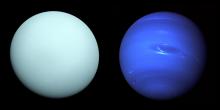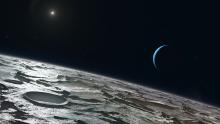Listen to today's episode of StarDate on the web the same day it airs in high-quality streaming audio without any extra ads or announcements. Choose a $8 one-month pass, or listen every day for a year for just $30.
You are here
First to Neptune
The Sun’s most-remote major planet is fascinating. It features the fastest winds in the solar system, and it once had a storm big enough to swallow Earth. Methane in its atmosphere gives it a beautiful blue color. And its biggest moon is dotted with giant geysers.
Yet Neptune — the fourth-biggest planet — has received only one visitor from Earth. Voyager 2 flew past it 30 years ago today. It discovered five moons and confirmed another. It also discovered four new rings around the planet. And it studied Neptune’s atmosphere and its magnetic field.
Neptune is about 30 times farther from the Sun than Earth is. At that distance, the Sun is only about a thousandth as bright as it is from Earth. So Neptune receives little heat from the Sun to power its weather.
Yet Voyager 2 discovered that Neptune’s atmosphere is dynamic — powered by heat from inside the planet. Voyager photographed a giant storm, known as the Great Dark Spot. Winds around it blew at more than a thousand miles per hour. And bright clouds that were close to it rose high above the rest of the atmosphere.
Voyager also looked at Neptune’s biggest moon, Triton. It found dozens of geysers of nitrogen ice. They deposited dark streaks that were miles long — something not seen on any other world in the solar system.
And Neptune is nearing its best showing of the year. It climbs into view in early evening, at the western edge of Aquarius. It’s so faint, though, that you need a telescope to see it.
Script by Damond Benningfield





